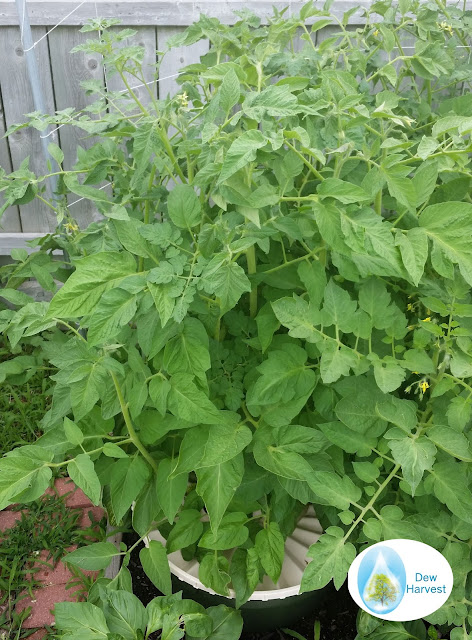The problem with heirloom tomatoes is watering. These tomatoes demand consistent water to their roots and generally need the same amount of water every day. Too little water and the tomato will not grow. If the tomato gets too much water at any one time (including from rain) the inside of the tomato fruit can grow faster than the skin and the tomato can split. Also, water from above can cause many diseases leaves or fruit itself - and it can be very difficult to only water the base once the tomato has grown large. We wanted to find a way to give the tomatoes consistent water while reducing the work of watering, as well as keep water off the leaves and fruits. We planned to do this by using the Groasis Waterboxx - as explained below.
We started our two Brandywine heirloom tomatoes inside and transplanted them outside into our raised bed on May 2 as seen below. We gave these tomatoes 4 square feet (2x2'), and planted two in this area. We used the evaporation cover that comes with the Waterboxx and prevents evaporation and weed growth to space the tomatoes. We then watered them well (with liquid fertilizer containing water), before finally placing the evaporation cover at the base of the plants. We then carefully set a Groasis Waterboxx over the top of the plants, being very careful not to damage the stems. We then filled the Waterboxx full of water with a hose (with approximately 4 gallons or 15 liters of non-fertilized water).
Waterboxx will be needed which we will document on this post.
 |
| The two heirloom tomatoes on May 19, 2015, 17 days after transplanting. These have not had any external water beside what is provided to them by the Waterboxx but continue to grow very well. |
On May 26, the water level was low enough in the Waterboxx due to the three extra wicks that we needed to manually refill it. The Waterboxx completely fills with 4 inches of rainfall, but May has been a dry month since planting. In previous years (before planting with the Waterboxx), we would have needed to water these tomatoes every other day to ensure the same level of growth.
 |
| The two heirloom tomatoes on June 18,2015. No fruits yet but some flowers are just now beginning. |
 |
| An heirloom Brandywine Tomato on June 30. This tomato hasn't had any water added manually in over a month, and yet it grows perfectly. |
We did add 4 small Jobe's organic fertilizer spikes to the soil around the Waterboxx sheltering the plants on July 1.
 |
| A nice ripe Waterboxx tomato on 7/27/2015- excellent for BLTs, salads, and pasta sauce. |
We had significant store damage earlier in the year to our tomato plants, but still managed to harvest 17 heirloom tomatoes from the Waterboxxes - all without any watering after May. Most of our neighbors never got even one tomato from their plants in this overly wet and overcast summer!
The Waterboxx eliminates the need for watering, prevents tomato splitting, and dramatically decreases work in the garden. You can buy the Groasis Waterboxx here. We are growing several other plants with the Waterboxx.
We would love to hear your comments below - to leave one, please click on "Comments".


Tidak ada komentar:
Posting Komentar